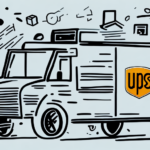Understanding UPS Shipping Rates with Tracking
If you are a business owner or frequently ship packages, UPS is likely one of your top choices for shipping carriers. However, the cost of shipping with UPS can add up quickly, making it essential to have a full understanding of their shipping rates and how tracking plays a role in these rates.
Why Tracking Matters in UPS Shipping Rates
One of the primary reasons why tracking matters when it comes to UPS shipping rates is that it affects the level of liability and insurance coverage provided. UPS offers different levels of liability coverage based on the type of tracking you choose. For example, packages sent with UPS Ground automatically have $100 of liability coverage, but you can purchase additional coverage or opt for a more robust level of tracking to secure higher liability coverage.
Another reason why tracking matters is that it allows you to closely monitor the progress of your shipment. You can ensure that your package is on time and adjust your plans as needed. With UPS, you can even receive real-time alerts for delivery status changes, so you never have to wonder where your package is or when it will arrive.
Additionally, tracking can help you identify potential issues with your shipment. If you notice that your package is delayed or has been rerouted, you can contact UPS to investigate the issue and potentially resolve it before it becomes a bigger problem. This proactive approach can save you time and money in the long run by avoiding the need to resend or replace lost or damaged items.
Finally, tracking provides valuable data and insights into your shipping patterns and habits. By analyzing your tracking information, you can identify areas for improvement in your shipping process, such as optimizing packaging or choosing more efficient shipping methods. This can help you save money on shipping costs and improve customer satisfaction by ensuring timely and reliable delivery of your products.
How to Calculate UPS Shipping Rates
Calculating UPS shipping rates can be complex, as several factors come into play. These include the weight and size of the package, the distance it is traveling, the shipping service you choose, and any additional fees or surcharges. To obtain an accurate estimate, you can use the UPS shipping calculator on their website or consult with a UPS representative.
It's essential to note that the size and weight of the package significantly impact your shipping rates. UPS considers both the actual weight and dimensional weight when calculating rates. Dimensional weight refers to the amount of space a package occupies relative to its actual weight. If the dimensional weight exceeds the actual weight, you will be charged based on the dimensional weight.
Another factor affecting UPS shipping rates is the type of item being shipped. Items such as hazardous materials or fragile goods may require special handling or packaging, resulting in additional fees. Properly labeling and packaging your items is crucial to avoid delays or extra charges.
Additionally, the time of year can impact UPS shipping rates. During peak holiday seasons, rates may be higher due to increased demand and limited availability. Planning ahead and scheduling shipments in advance can help you avoid last-minute rush fees or delays.
Different Types of UPS Shipping Services
UPS offers a variety of shipping services to accommodate diverse delivery needs, including:
- UPS Ground
- UPS 2nd Day Air
- UPS Next Day Air Saver
- UPS Next Day Air
- UPS Worldwide Express
- UPS Worldwide Saver
The type of service you choose will impact your shipping rates, with faster delivery options generally costing more. Additionally, UPS offers various packaging options, including their own branded packaging or standard packaging. Ensure you select packaging appropriate for the size and weight of your package to avoid additional surcharges or fees.
UPS also provides additional services such as signature confirmation, insurance, and delivery confirmation. These services enhance security and offer peace of mind for both the sender and recipient of the package. However, they may come with extra fees, so it's important to weigh the benefits against the costs.
Another critical factor to consider when selecting a UPS shipping service is the destination of your package. UPS offers international shipping services to over 220 countries and territories, but delivery times and rates can vary depending on the destination. It's important to research any customs regulations or restrictions that may apply to your package before shipping it internationally.
Factors That Affect UPS Shipping Rates
Apart from the weight and size of your package and the shipping service you choose, several other factors can influence your UPS shipping rates. These include:
- The destination and origin zip codes
- The type of package or shipment
- Additional fees for address correction or delivery to remote locations
- Fuel surcharges
Considering all these factors when selecting your shipping option is crucial to obtaining the most accurate estimate possible.
Another factor that can affect UPS shipping rates is the delivery time frame. If you require your package to be delivered within a specific time frame, such as overnight or two-day delivery, you may need to pay a higher rate. Additionally, the value of the contents of your package can also impact the shipping rate, as UPS offers additional insurance options for high-value items. Factoring in all these variables when selecting your shipping option ensures that your package arrives on time and within your budget.
How to Negotiate Better UPS Shipping Rates
If you frequently ship with UPS, you may be able to negotiate better shipping rates. Some strategies include:
- Consolidating shipments to reduce the number of packages you send
- Working with a UPS representative to negotiate a preferred pricing agreement
- Selecting the most cost-effective shipping option for your needs
Keep in mind that negotiating better rates may require a minimum shipping volume, so consult with a UPS representative to determine if you qualify.
Another approach to potentially securing better UPS shipping rates is utilizing UPS's online shipping tools. By using these tools, you may access discounted rates not available through other channels. Additionally, you can track your shipments and manage your account online, which can save you time and money in the long run.
Tips for Reducing Your UPS Shipping Costs
In addition to negotiating better rates, several other methods can help reduce your UPS shipping costs, including:
- Selecting the most cost-effective shipping option
- Consolidating packages
- Using your own packaging instead of UPS-branded packaging
- Optimizing package size and weight to minimize dimensional weight
- Printing shipping labels online to avoid in-person fees
Implementing these tips can help you save money on your UPS shipping costs and increase your overall profitability.
Another way to reduce your UPS shipping costs is by taking advantage of UPS's discounts and promotions. UPS offers various discounts and promotions throughout the year, such as discounts for small businesses and seasonal promotions. By staying informed about these discounts and promotions, you can save even more on your shipping expenses.
Properly packaging your items is also essential to avoid damage during shipping, which can lead to additional costs and delays. Use appropriate packaging materials, such as bubble wrap or packing peanuts, and secure the items inside the box to prevent movement. By ensuring your items are well-packaged, you can avoid extra costs and guarantee that your items arrive safely.
How to Compare UPS with Other Shipping Carriers
When selecting a shipping carrier, it's crucial to compare UPS with other carriers to ensure you're getting the best rates and services. Some popular shipping carriers to compare with UPS include FedEx, USPS, and DHL. Factors to consider when comparing carriers include:
- Shipping rates
- Delivery options
- Tracking capabilities
- Insurance and liability coverage
- Additional fees and surcharges
By carefully evaluating these factors, you can make an informed decision when choosing a shipping carrier that best meets your needs.
It's also important to consider the reputation of the shipping carrier. Look for reviews and feedback from other customers to assess the carrier's reliability and efficiency. Additionally, consider the geographical coverage of the carrier. If you frequently ship to international destinations, you may prefer a carrier with a strong global network.
How to Track Your UPS Shipment
Tracking your UPS shipment is straightforward and convenient. You can use the UPS tracking tool on their website or utilize their mobile app for on-the-go tracking. To track your package, you'll need your tracking number, which can be found on your shipping label.
Once you have your tracking number, simply enter it into the tracking tool on the UPS website or app. You'll be able to view the current status of your package, including its location and estimated delivery date. If there are any delays or issues with your shipment, the tracking tool will provide updates on those as well.
In addition to tracking your package, UPS offers various shipping options to suit your needs. You can choose from standard ground shipping, expedited shipping, or even same-day delivery in some areas. UPS also provides packaging supplies and services, such as printing shipping labels and scheduling pickups for your packages.
Understanding the Status Updates in Your UPS Tracking Information
When tracking your UPS shipment, you'll encounter various status updates along the way. These updates can include:
- Order processed
- Package received
- Departure scan
- Arrival scan
- Out for delivery
- Delivered
Understanding these updates provides insight into the progress of your package and ensures that it is on track for timely delivery.
Troubleshooting Common Issues with UPS Tracking
If you encounter issues with UPS tracking, there are several common solutions to try:
- Verify that your tracking number is correct
- Allow time for the tracking information to update
- Contact UPS customer service for additional assistance
If problems persist, it may be a technical error, and contacting UPS customer service for further guidance is recommended.
Best Practices for Using UPS Shipping and Tracking
Overall, some best practices for using UPS shipping and tracking include:
- Selecting the most cost-effective shipping option for your needs
- Using your own packaging and optimizing package size and weight
- Regularly tracking your shipment and monitoring its progress
- Communicating with UPS customer service regarding any questions or concerns
By adhering to these best practices, you can ensure a smooth and cost-effective shipping experience with UPS.




















